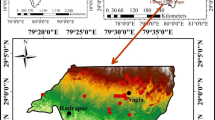Abstract
Stream-power incision model has always been applied to detecting the steady-state situation of ranges. Oblique arc-continent collision occurring during the period of Penglai Orogeny caused the Taiwan mountain belt to develop landscape of three evolution stages, namely stages of pre-steady-state (growing ranges in southern Taiwan), steady-state (ranges in central Taiwan) and post-steady-state (decaying ranges in northern Taiwan). In the analysis on streams of the Taiwan mountain belt made by exploring the relationship between the slope of bedrock channel (S) and the catchment area (A), the topographic features of the ranges at these three stages are acquired. The S-A plot of the steady-state ranges is in a linear form, revealing that the riverbed height of bedrock channel does not change over time (dz/dt = 0). The slope and intercept of the straight line S-A are related to evolution time of steady-state topography and tectonic uplift rate respectively. The S-A plots of the southern and northern ranges of Taiwan mountain belt appear to be in convex and concave forms respectively, implying that the riverbed height of bedrock channel at the two ranges rises (dz/dt > 0) and falls (dz/dt < 0) over time respectively. Their tangent intercept can still reflect the tectonic uplift rate. This study develops an empirical stream-power erosion model of pre-steady-state and post-steady-state topography.
Similar content being viewed by others
References
Flint J J. Stream gradient as a function of order, magnitude, and discharge. Wat Resour Res, 1974, 10: 969–973
Willgoose G R, Bras R L, Rodriguez-Iturbe I. A model of river basin evolution. EOS (Transaction, American Geophysical Union), 1990, 71: 1806–1807
Tarboton D G, Bras R L, Rodriguez-Iturbe I. On the extraction of channel networks fromdigital elevation data. Hydrol Proce, 1991, 5: 81–100
Howard A D, Kerby G. Channel changes in badlands. Geol Soc Am Bull, 1983, 94: 739–752
Anderson R S. The growth and decay of the Santa Cruz Mountains. J Geophys Res, 1994, 99: 20161–20180
Howard A D. A detachment-limited model of drainage basin evolution. Wat Resour Res, 1994, 30: 2261–2285
Howard A D, Seidl M A, Dietrich W E. Modeling fluvial erosion on regional to continental scales. J Geophys Res, 1994, 99: 13971–13986
Whipple K, Tucker G E. Dynamics of the stream-power river incision model: Implications for height limits of mountain ranges, landscape response timescales, and research needs. J Geophys Res, 1999, 104: 17661–17674
Whipple K, Hancock G, Anderson RA. River incision into bedrock: Mechanics and relative efficacy of plucking, abrasion, and cavitation. Geol Soc Am Bull, 2000, 112: 490–503
Seno T. The instantaneous rotation vector of the Philippine Sea plate relative to the Eurasian plate. Ectonophys, 1977, 42: 209–206
Ho C S. A synthesis of the geologic evolution of Taiwan. Tectonophys, 1986, 125: 1–16
Teng L S. Stratigraphy records of the late Cenozoic Penglai orogeny of Taiwan. Acta Geol Taiwan, 1987, 25: 205–224
Teng L S. Geotectonic evolution of late Cenozoic arc-continent collision in Taiwan. Tectonophys, 1990, 183: 57–76
Suppe J. Mechanics of mountain-building and metamorphism in Taiwan. Mem Geol Soc China, 1981, 4: 67–90
Lee C T. Methods of stress analysis and paleostress changes in northern Taiwan due to arc-continent collision. Dissertation for the Doctoral Degree. Taipei: Institute of Geosciences, National Taiwan University, 1986. 370
Teng L S, Lee C T, Peng C H, et al. Origin and geological evolution of the Taipei Basin northern Taiwan. Western Pacific Earth Sci, 2001, 1: 115–142
Teng L S. Extensional collapse of the northern Taiwan mountain belt. Geology, 1996, 24: 945–952
Stark C P, Hovius N. Evolution of a mountain belt toward steady state: analysis of the Central Range, Taiwan. EOS (Transactions of the American Geophysical Union), 1998, 79: 357
Suppe J. Kinematics of arc-continent collision, Flipping of subduction, and back-arc spreading near Taiwan. Mem Geol Soc China, 1984, 6: 21–33
Suppe J. The active mountain belt. In: Schaer S P, Rodgers J, eds. The Anatomy of Mountain Ranges. New Jersey: Princeton University Press, 1987. 277–293
Hovius N, Stark C P, Chu H T, et al. Supply and removal of sediment in a Landslide-Dominated Mountain Belt: Central Range, Taiwan. The J Geol, 2000, 108: 73–89
Stark C P, Stark G J. A channelization model of landscape evolution. Am J Sci, 2001, 301: 486–512
Willett S D, Brandon M T. On steady states in mountain belts. Geology, 2002, 30(2): 175–178
Whipple K X. Fluvial landscape response time: How plausible is steady-state denudation? Am J Sci, 2001, 301: 313–325
Willett S D, Slingerland R, Hovius N. Uplift, Shortening, and Steady-State Topography in Active Mountain Belts. Am J Sci, 2001, 301: 455–485
Chen Y C. Morphotectonic features of Taiwan Mountain Belt based on hypsometric integral, topographic fractals and SL index, Tainan. Dissertation for the Doctoral Degree. Taipei: Institute of Earth Sciences, National Cheng Kung University, 2004. 129
Montgomery D R, Foufoula-Georgiou E. Channel network source presentation using digital elevation models. Wat Resour Res, 1993, 29(12): 3925–3934
Ohmori H. Change in the mathematical function type describingthe longitudinal profile of a river through an evolutionary process. J Geol, 1991, 99: 97–110
Liu T K, Hsieh S, Chen Y G, et al. Thermo-kinematic evolution of the Taiwan oblique-collision mountain belt as revealed by zircon fission track dating. Earth Planet Sci Lett, 2001, 186: 45–56
Hack J T. Stream-profile analysis and stream-gradient index, U.S. Geol Surv Jour Res, 1973, 1: 421–429
Snyder N, Whipple K, Tucker G, et al. Landscape response to tectonic forcing: digital elevation model analysis of stream profiles in the Mendocino triple junction region, northern California. Geol Soc Am Bull, 2000, 112: 1250–1263
Author information
Authors and Affiliations
Corresponding author
About this article
Cite this article
Chen, YC., Sung, Q. & Chen, CN. Stream-power incision model in non-steady-state mountain ranges: An empirical approach. CHINESE SCI BULL 51, 2789–2794 (2006). https://doi.org/10.1007/s11434-006-2194-x
Received:
Accepted:
Issue Date:
DOI: https://doi.org/10.1007/s11434-006-2194-x




